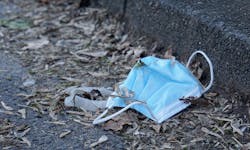COVID-19 healthcare waste exposes need to improve waste management systems
Tens of thousands of tons of extra medical waste from the response to the COVID-19 pandemic has put tremendous strain on healthcare waste management systems around the world, threatening human and environmental health and exposing a need to improve waste management practices, according to a new report from the World Health Organization (WHO).
The WHO bases it analysis and recommendations on the approximately 87,000 tons of personal protective equipment (PPE) that was procured between March 2020-November 2021 and shipped to support countries’ COVID-19 response needs through a joint UN emergency initiative. The WHO said it expects that most of this equipment is expected to have ended up as waste.
The WHO notes that "this just provides an initial indication of the scale of the COVID-19 waste problem. It does not take into account any of the COVID-19 commodities procured outside of the initiative, or waste generated by the public like disposable medical masks.They point out that over 140 million test kits, with a potential to generate 2,600 ton of non-infectious waste (mainly plastic) and 731,000 liters of chemical waste (equivalent to one-third of an Olympic-size swimming pool) have been shipped, while over 8 billion doses of vaccine have been administered globally, producing 143 tons of additional waste in the form of syringes, needles, and safety boxes."
As Michael Ryan, Executive Director, WHO Health Emergencies Program, said, “It is absolutely vital to provide health workers with the right PPE, But it is also vital to ensure that it can be used safely without impacting on the surrounding environment.”
This means having effective management systems in place, including guidance for health workers on what to do with PPE and health commodities after they have been used, the WHO said.
“Approximately 30% of healthcare facilities (60% in the least developed countries) are not equipped to handle existing waste loads, let alone the additional COVID-19 load. This potentially exposes health workers to needle stick injuries, burns and pathogenic microorganisms, while also impacting communities living near poorly managed landfills and waste disposal sites through contaminated air from burning waste, poor water quality or disease carrying pests,” the WHO said.
The report lays out a set of recommendations for integrating better, safer, and more environmentally sustainable waste practices into the current COVID-19 response and future pandemic preparedness efforts and highlights stories from countries and organizations that have put into practice in the spirit of “building back better."
Recommendations include using eco-friendly packaging and shipping, safe and reusable PPE (e.g., gloves and medical masks), recyclable or biodegradable materials; investment in non-burn waste treatment technologies, such as autoclaves; reverse logistics to support centralized treatment and investments in the recycling sector to ensure materials, like plastics, can have a second life.

